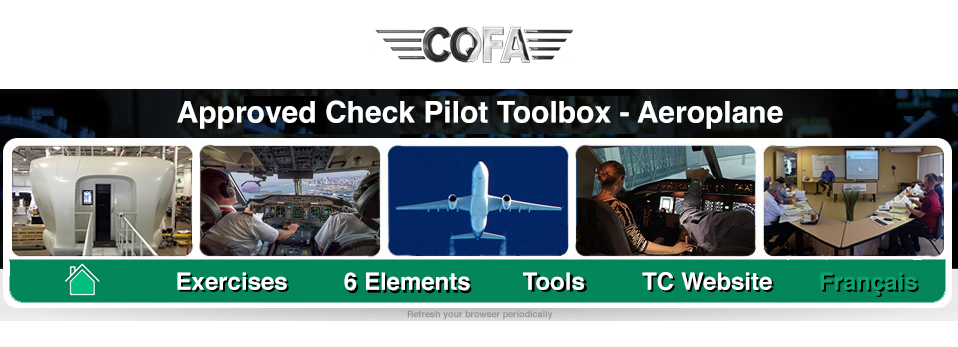2. Flight planning (FLP)
Aim
Determine the candidate’s ability to plan a flight utilizing performance charts, weight and balance calculations, conforming to the VFR or IFR flight rules as applicable and retrieving and interpreting aviation weather information necessary for the safe conduct of the flight.
Description
The ACP will conduct a flight planning practical examination requiring the candidate to demonstrate a knowledge of the air operators approved standard operating procedures and the Aeroplane Flight Manual including aeroplane and runway performance charts where applicable, loading, weight and balance procedures and Flight Manual Supplements.
For 704 and 705 PPC’s the flight planning examination is optional when the pilot’s training record contains a valid written examination, from initial or annual training.
Performance Criteria
(06/2017 FTG p.16-17) Assess on the candidate’s ability to:
- demonstrate a practical knowledge of performance and limitations, including a the adverse effects of exceeding any limitation;
- demonstrate proficient use of (as appropriate to the aeroplane) performance charts, tables, graphs, or other data relating to items, such as:
- accelerate-stop distance
- accelerate-go distance
- takeoff performance—all engines, engine(s) operating climb performance including segmented climb performance; with all engines operating — with one or more engine(s) inoperative, and with other engine malfunctions as may be appropriate
- service ceiling—all engines, engines(s) inoperative, including drift down, if appropriate
cruise performance - fuel consumption, range, and endurance
- descent performance
- go-around from rejected landings
- other performance data (appropriate to the aeroplane)
- describe (as appropriate to the aeroplane) the airspeeds used during specific phases of flight;
- describe the effects of meteorological conditions upon performance characteristics and correctly applies these factors to a specific chart, table, graph, or other performance data;
- compute the centre-of-gravity location for a specific load condition (as specified by the examiner), including adding, removing, or shifting weight;
- determine if the computed centre-of-gravity is within the forward and aft centre-of-gravity limits, and that lateral fuel balance is within limits for takeoff and landing for the proposed flight;
- demonstrate acceptable planning and knowledge of procedures in applying operational factors affecting aeroplane performance;
- select an appropriate route, altitude and alternate;
- locate and apply information essential to the flight;
- obtain and correctly interpret applicable NOTAM information;
- calculate the estimated time enroute and total fuel requirement based on factors such as power settings, operating altitude or flight level, wind and fuel reserve requirements;
- determine that the required performance for the planned flight is within the aircraft’s capability and operating limitations;
- make a competent “GO/NO-GO” decision based on available information for the planned flight;
- complete a flight plan in a manner that reflects the conditions of the proposed flight;
- demonstrate sufficient practical operational knowledge of the regulatory requirements relating to instrument and visual flying, as applicable; and
- retrieve and interpret items such as weather reports and forecasts; pilot and radar reports; surface analysis charts; significant weather prognostics; winds and temperatures aloft; freezing level charts, NOTAMS and SIGMETs.
Commenting a "1"
- Selected route based on unserviceable navaids.
- Did not check NOTAMs.
- Invalid alternate airport selection due to unserviceable airport facilities (navaids, forecast Wx).
- Unable to interpret NOTAM information.
- Incorrect estimated en route time, and/or total fuel requirement (incorrect aircraft performance, power settings, planned altitude/FL, wind and/or fuel reserve requirement).
- Did not know/understand/comply with CAR 602.88 fuel requirement
- Incorrect W&B figures. Did not obtain/check W&B. Obtained W&B figures but did not crosscheck.
- Planned route exceeded aircraft capabilities/limitations.
- Unable to (did not) obtain/apply information essential to the flight.
- Incorrect flight planning, not reflecting expected conditions of proposed flight. Flight planning not in accordance with COM.
- Incorrect regulatory knowledge related to the intended flight.
- Unable/did not check aircraft airworthiness (documents).
- Unable to use performance charts/data.
Commenting a "2"
- Initial planning incorrect, but corrections applied and communicated before take-off.
- Late check of NOTAMS causing departure delays.
- Initial alternate airport selection invalid. Correct selection made before take-off.
- Discrepancies in flight time/fuel required calculations in relation with FL and/or winds. Correct figures obtained and discussed before take-off.
- Initial confusion regarding route selection and aircraft performance. Correct route filed with help of dispatcher/operations.
- Errors made during flight planning with regard to proposed/planned conditions. Several corrections attempted before correct route planned and filed.
- Flight planning complied to CAR 602.88 only after looking up CARs
- Knowledge of regulations shows gaps requiring help of other crew member/dispatch.
- Limited knowledge of aircraft documents during prefight, and/or required help from other crewmember to verify aircraft airworthiness.
- Use of performance charts/data generated repeated mistakes. Corrected by other crewmember (or dispatch).
- Poor knowledge of LAHSO requirements. Unable to determine if intended landing is within LDA.
